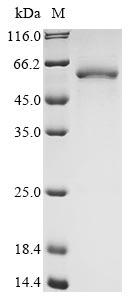Unlock the potential of developmental biology research with our superior quality Recombinant Human LINGO1 protein. LINGO1 is an essential protein involved in nervous system development and regeneration. Its functional importance in the regulation of axonal growth and myelination, as well as its association with neurodegenerative and psychiatric disorders, makes LINGO1 a significant target for investigating the complex processes governing the development and maintenance of the nervous system.
This Recombinant Human LINGO1 protein has been expertly produced in E. coli, ensuring efficient and consistent expression. Representing a partial region of the protein (42-561 amino acids), it retains the functionality and structural integrity of the native protein. The N-terminal 6xHis-tag ensures easy purification, while maintaining the protein's bioactivity. With a purity of greater than 85% as determined by SDS-PAGE, this Recombinant Human LINGO1 protein is a reliable and robust choice for advancing your developmental biology research. Opt for our high-quality protein to elevate your experiments and unravel new insights into the intriguing world of nervous system development.






